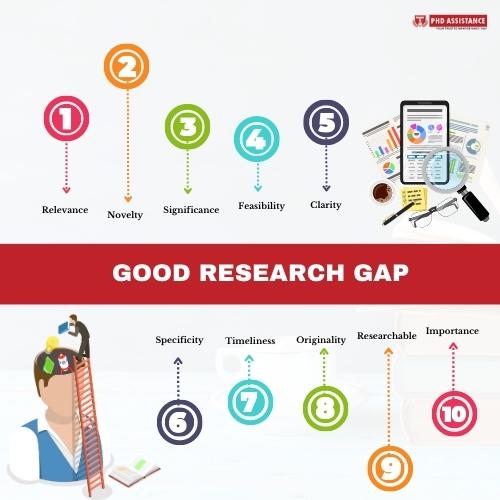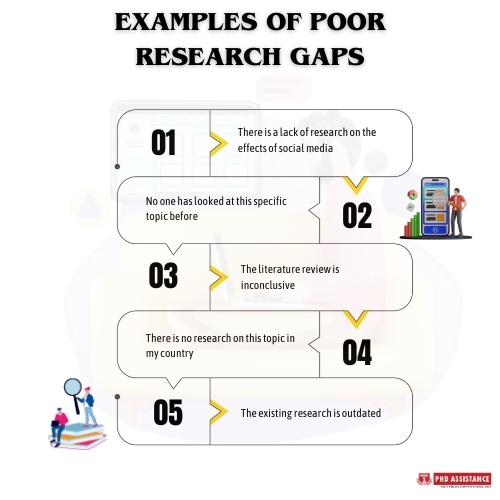What is a research gap? Is there a good or poor research gap?
Introduction
A research gap refers to a research question or area that has not been sufficiently addressed or answered in previous studies. It is an area where further research is needed to advance the current knowledge and understanding of a particular topic. Identifying research gaps in the literature review is important as it helps establish a study’s relevance and significance and can lead to the development of new research questions and hypotheses.
What is a research gap example?
A research gap signifies an unexplored terrain within existing knowledge, spotlighting an area lacking comprehensive investigation. Imagine, in medical research, a void in understanding the long-term effects of a newly developed treatment. This gap identification demands inquiry to bridge the chasm between current understanding and untapped insights. It’s akin to a puzzle with a missing piece, urging scholars to unravel hidden complexities. Such gaps drive scholarly exploration, fostering innovation and a deeper grasp of intricate subjects. Identifying and addressing these literature gaps in research pave the way for scientific advancement, enhancing our comprehension of the world around us.

Good research gap
A good research gap is a specific area of knowledge or a problem that has not been adequately addressed or explored in the existing literature. Here are 10 points that are typically considered mandatory in a good research gap:
- Relevance: The quantitative research gap example should be relevant to the field of study and have practical significance.
- Novelty: It should identify a new, unexplored area of research or a new angle for examining an existing research topic.
- Significance: The gap should be significant enough to warrant further investigation and have the potential to contribute to the existing body of knowledge.
- Feasibility: The research question should be feasible and realistic, taking into account factors such as time, resources, and available data.
- Clarity: The gap should be clearly defined, not too broad or too narrow.
- Specificity: The gap should be specific enough to allow for targeted research.
- Timeliness: The research question should be relevant to current issues or concerns in the field.
- Originality: The gap should be original and not simply a replication of previous research.
- Researchable: The gap should be researchable, meaning that data can be collected and analyzed to answer the research question.
- Importance: The research gap should be important enough to justify the time and resources required to conduct the research.
Poor research gap
“Poor research gap” refers to a situation where there is either no research gap identified in the existing literature or the identified research gap is not significant enough to contribute to the field of study. It means that the proposed research would not add any value to the existing knowledge base or research in the field.

Here are some examples of poor research gaps:
- “There is a lack of research on the effects of social media.”
This research gap is too broad and does not identify a specific research question or problem. It does not provide any direction for the research.
- “No one has looked at this specific topic before.”
This research gap is not valid as it is unlikely that no one has ever looked at the topic before. It is also too broad and does not provide any direction for the research.
- “The literature review is inconclusive.”
This research gap does not identify a specific problem or research question. It also does not provide any direction for the research.
- “There is no research on this topic in my country.”
This research gap is too narrow and does not consider research conducted in other countries. It also does not provide any direction for the research.
- “The existing research is outdated.”
This research gap does not identify a specific problem or research question. It also does not provide any direction for the research.
- Check out our sample PhD Gap identification examples to see how PhD Gap identification is obtained.
Tools to Assist with Your Research Gap
Staying updated on the latest literature can be overwhelming due to the thousands of new articles published daily. Utilizing technology like PubCrawler, Feedly, Google Scholar, and PubMed updates can help keep you updated. Social media platforms like Twitter and reference managers like Mendeley can also help organize your references. Identifying the research gap in the dissertation requires a thorough literature review, but it’s important to set boundaries and not read every paper on a topic. Finding a paper you had intended to write is possible, but don’t give up. Keep reading, and you’ll find what you’re looking for. Identifying research gaps requires an extensive literature review, but don’t give up and keep reading to find what you’re looking for.
- Check out our study guide to learn more about Identifying Research Gaps to Pursue Innovative Research.
Conclusion
In conclusion, a research gap signifies the unexplored terrain within a field where existing literature falls short. It is the pivot for innovation and advancement, propelling scholarly inquiry forward. A research gap can be either promising or inadequate. A significant research gap opens doors to groundbreaking discoveries, generating insightful contributions. Conversely, a poor research gap might lead to redundant studies or trivial outcomes. Recognizing and addressing a research gap thoughtfully can guide researchers toward valuable inquiries, enriching the academic landscape. Ultimately, the quality of a research gap lies in its potential to ignite meaningful exploration and cultivate knowledge that shapes the trajectory of a discipline.
About PhD Assistance
At PhD Assistance, we discover research gaps not only by a broad examination of current published literature but also through a detailed study of the material by categorizing it into geographical origin settings and multi-component-based research. This segregation identifies the disparity not only in the idea but also in the demographic components of the study. This well-rounded strategy results in a more defined and concentrated research field, which adds much-needed innovation to an academic research study.
References
- Davis, Stephen H. “Bridging the gap between research and practice: what’s good, what’s bad, and how can one be sure?.” Phi Delta Kappan8 (2007): 569-578. https://doi.org/10.1177/00317217070880080
- Tavernise, Sabrina. “Education gap grows between rich and poor, studies say.” The New York Times9 (2012).
 Previous Post
Previous Post
